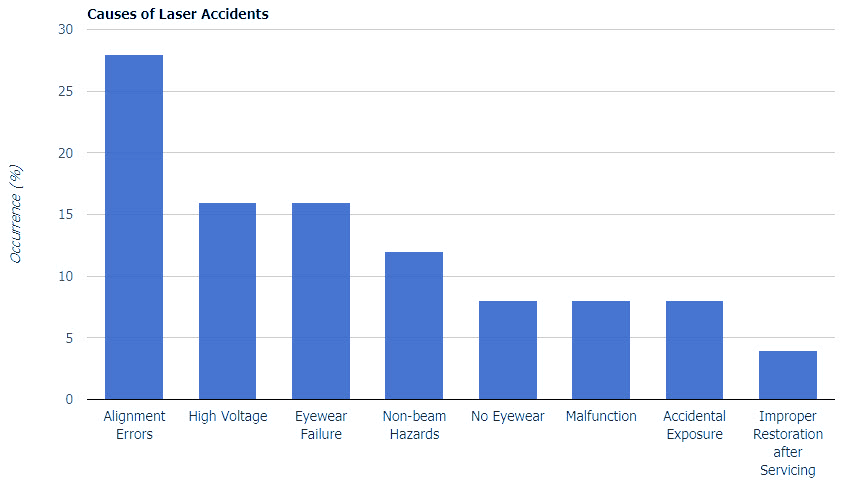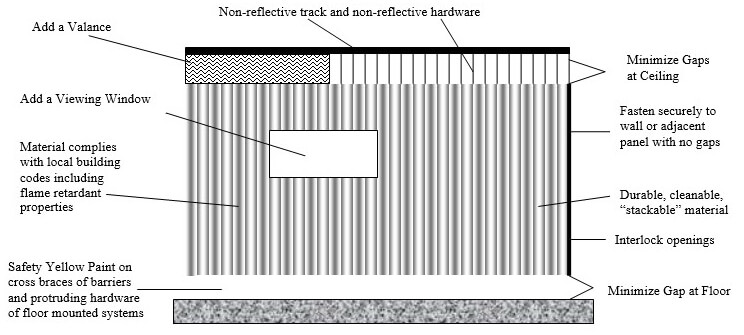Practical Observations Of Laser Safety
A Laser Safety Mandate
Too often, a laser user’s first view of laser safety is into the world of MPE, OD, L Rating, Nominal Hazard Zone, LSO and beam divergence. Available evidence suggests, however, that non-beam hazards and work place habits should be of at least equal concern to the supervisors of laser installations. From incident data collected during the past 30-plus years, it is apparent that human error is a critical factor in unsafe laser use.

(Exhibit 1) Exhibit 1 Source: Rockwell Laser Industries (with permission)
At Kentek Corporation, our view of laser safety issues is through the eyes of our many thousand customers worldwide. We work with laser end-users daily to solve their laser safety problems. We are often surprised at the lack of laser knowledge and awareness exhibited by laser users. More surprising are the laser safety solutions that create other hazards when not properly implemented. We provide here several real-life situations encountered by our team that should provide some practical if not useful insights into laser safety. Our aim is to provide Laser Safety Officers and shop floor supervisors clues to watch for when trying to ascertain the safe use of lasers in industrial and research settings. From this work we propose a laser safety checklist to supplement existing regulations, industry standards, best practices and laser manufacturers’ recommendations. We also propose that laser safety programs be more closely integrated with general work place safety guidelines and organizations.
Eyewear that Speaks
A job shop customer returned a pair of eyewear with a broken frame in hopes of having the product replaced in accordance with the warrantee offered at the time of sale. Several characteristics of this very worn pair of laser safety glasses left a lasting impression. First, one of the temples had been stressed beyond the point at which the eyewear would remain safely in place under any circumstances. Second, the brow bar, which provides both support and additional protection had been removed. Third, both of the glass lenses were spattered with “slag”, tiny speckles of molten metal. How close to the machine was the operator, the individual who sent us the eyewear? Have you examined the safety eyewear issued to your workers? The condition of eyewear and other personal protective equipment can provide an indication of unsafe behavior. If the equipment looks too good, however, you should ask whether it is being used.
A Hole in the Wall
Similarly, walls, curtains, barriers and enclosures should be inspected for holes, burn marks and other indications of misdirected laser energy. When ever possible, laser beams should point down – raw beams should not emanate away from the vertical plane. We have found burn holes and scorch marks in a number of installations. We have also observed untested or uncertified materials such as plywood and vinyl being used as beam stops. Some personnel viewed the burn marks in these materials as a sort of “badge of courage”. Inspecting the entire perimeter of the lab or workspace with the personnel who work there will provide an opportunity to discuss the safety of both the direct staff and any personnel in neighboring spaces.
Watch Your Step!
In the laser labs of a very highly regarded research institution, the best minds in the world were working with skilled technicians in a state of the art facility to develop new lasers and find new applications. We also found general clutter and miscellaneous obstructions including cooling lines laid across the floors; that basic housekeeping was amiss, despite the attention to protection from laser radiation. When a young lab worker invited us, unprotected, into the proximity of an ongoing laser experiment, we realized that laser safety equipment alone is not enough. Individual behaviors must be modified with training and reinforcement. The emphasis must be on overall safety, not just laser safety.
Something in the Air
At least two corollaries follow from this call to pay attention to the condition of the work environment. First, mitigate the risks associated with assist gases like oxygen and other media which may be present alongside the laser system and which may create a fire or explosion hazard if the laser beam acts on them. Second, evaluate the gas and particulate matter created by the laser process. Laser generated airborne contaminants (LGACs) are evident in every laser process and range from nuisance to extreme hazard. (Exhibit 2)
Exhibit 2
| Laser Process | Sample of Likely By-Products |
|---|---|
| CO2 Laser Mark PVC Labels | Benzene, Toluene, Styrene, HCl, PAH, others |
| CO2 Laser Cut Lucite | Methyl methacrylate, others |
| Laser Cut Stainless Steel | Chromium, Nickel, Selenium, others |
| Laser Surgical Procedures | Formaldehyde, Hydrogen cyanide, others Also – Infectives (e.g. HIV) survive in the plume |
Style and Color Matter
Recent advances in laser safety eyewear have resulted in cost-effective designs that offer excellent, gap-free protection, lightweight polymer and glass constructions and attractive styling. This variety virtually guarantees that the end-user can find at least one model that fits his/her unique cranium and budget. We are dismayed by the number of environments driven by accounting into a “one size fits all mentality”. If forced down this path, the manager should try to ensure that a model is selected with both tilt-ratcheting and length-adjustable temples because these afford the best comfort; after all, no one will wear an uncomfortable item. Select a model that fits the particular work environment. For example, impact resistance is a requirement that is easily over-looked when sourcing laser safety eyewear. Or consider the visible light transmission offered by the filter – can personnel work safely given the room-darkening effects created by most laser safety eyewear? A third and less obvious characteristic is retention. We have heard complaints that frame designs with straight temples that do not wrap around the ear are not suitable for environments where the laser operators face downward because the eyewear has a tendency to slip off the head. We recommend the use of retention straps at all times because it is impossible to predict when something in the work area may cause the laser operator to suddenly shift his head position. Even the simple act of picking up a dropped tool can create a hazardous situation under the right circumstances. Finally, consider the wavelengths that are attenuated by the filter. If the equipment operator needs to watch for a red light during the process, either his eyewear should not block out those wavelengths or the process indicator should be changed. This type of problem is common in medical applications where the physicians can not easily see veins and other skin characteristics.
To Lase? Or not to Lase?
At one site, we found a very neat-looking laser enclosure fabricated with polymeric viewing windows inserted into an aluminum frame. The windows were tinted to a color that is common for laser safe viewing acrylic. This ordinary acrylic sheet from a local manufacturer provided dust protection for the optics and instruments. We were told that the operators of the equipment within the enclosure always wore laser protective eyewear. If the enclosure is not laser safe, it should not be designed to look laser safe. Further, appropriate warning labels and signs located at the entrance to the room as well as on and near the enclosure are warranted. A variation on this theme concerns the eyewear itself. When asked what types of lasers he was working with, a job shop technician indicated that he was marking with both Nd:YAG and CO2 laser systems. When asked about personal protection, this same person remarked that he just grabs a pair of laser safety glasses from the shelf and that he prefers a certain pair with clear lenses: “The clear ones are better because I can see better.” It turns out that this hapless technician was operating his YAG marker while wearing CO2 only protection. Although the supervisors at this company provided the laser safety tools, they did not provide either training or control procedures that would ensure the proper use of the equipment.
Barrier Design
We have uncovered a host of issues concerning the safe design and installation of both fixed laser safety curtain systems and movable laser safety barriers. At one extreme is the end-user who installed heavy black paper in the windows of his laboratory reasoning that the amount of laser energy that would reach these surfaces under normal conditions was very diffuse and of low power. There are many unplanned events that can create a hazard: a pen could fall out of a shirt pocket and inadvertently move a mirror, an elbow could bump against optics while the technician is making adjustments on his table, a loud noise or unexpected entry could startle the technician. Always plan for a reasonable worst case. Laser curtain and barrier materials are available with ratings for low power, 100 watts/cm2 for example, and higher powers like 300 watts/cm2 or even 1200 watts/cm2. We have experienced at least one inquiry for a barrier capable of blocking many thousands of Watts. Such a barrier can be designed and built, but we question the safety of live personnel in any space where such an extreme amount of laser energy is likely to be present - even wearing a suit of armor would not protect the laser user from potential burns.. In cases such as this, appropriate Class 1 enclosures and beam tubes must be coupled with carefully articulated and monitored control procedures including interlocks, lock out-tag out procedures, visible and possibly audible control signals, and emergency shutdown mechanisms. Assuming that the proper barrier materials are selected, overall design and installation become important. Gaps, reflective surfaces and parts that wear are to be minimized. The adjoining diagram (Exhibit 3) provides some design criteria for laser safety curtains and barriers.
Exhibit 3
Laser Barrier Design Criteria

In Conclusion
Lasers can seem mysteriously powerful but we are convinced that the user does not need a PhD in Physics to operate a laser system safely. The newly delivered laser system will come with emergency shut off and interlockable circuits. The user’s manual will describe the recommended eyewear and how to set up a safe laser work place. From here, it is up to the end user to use basic common sense and to follow well-known industrial safety guidelines. It is important to identify and train a Laser Safety Officer who can evaluate beam and non-beam hazards. The solutions offered by the LSO, however, must be integral to the site’s overall safety program. Personnel need to be trained, awareness levels need to be maintained, routine inspections and walk-throughs need to be scheduled. After all , we are only human!
